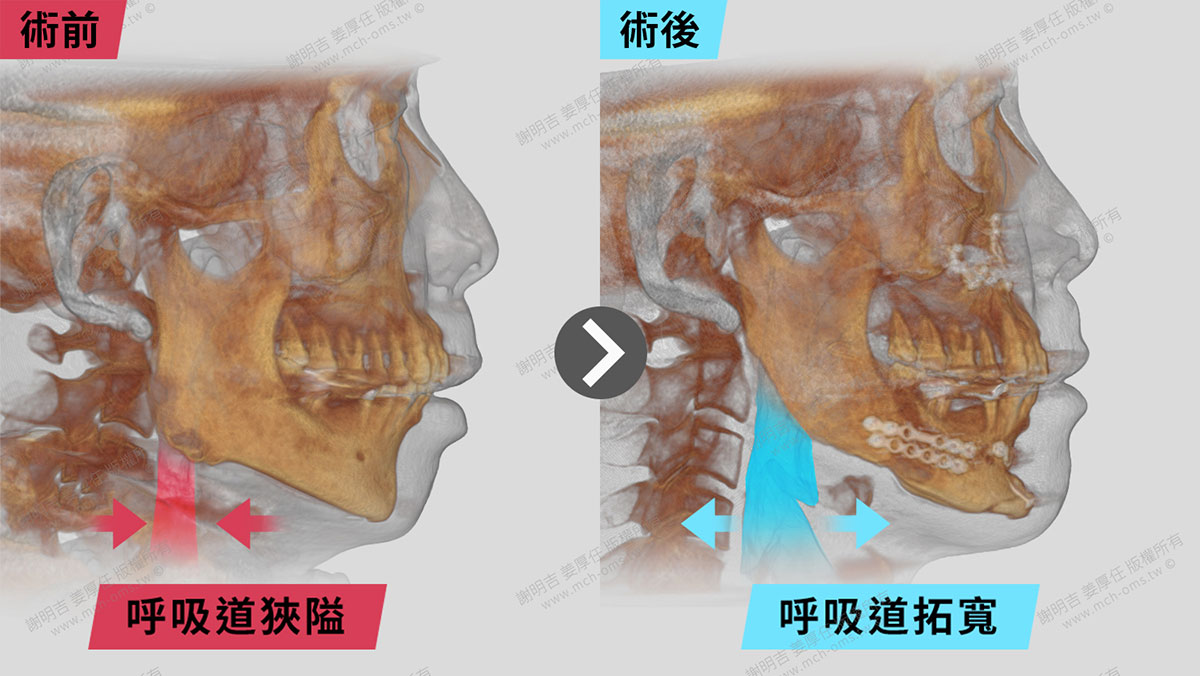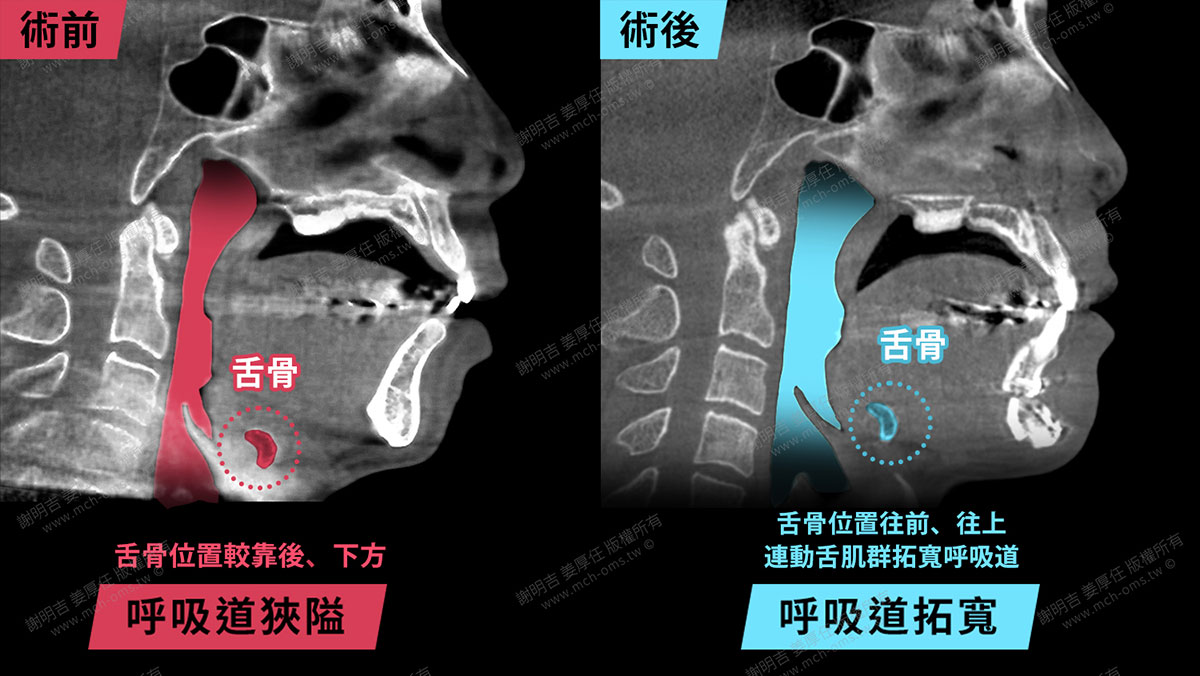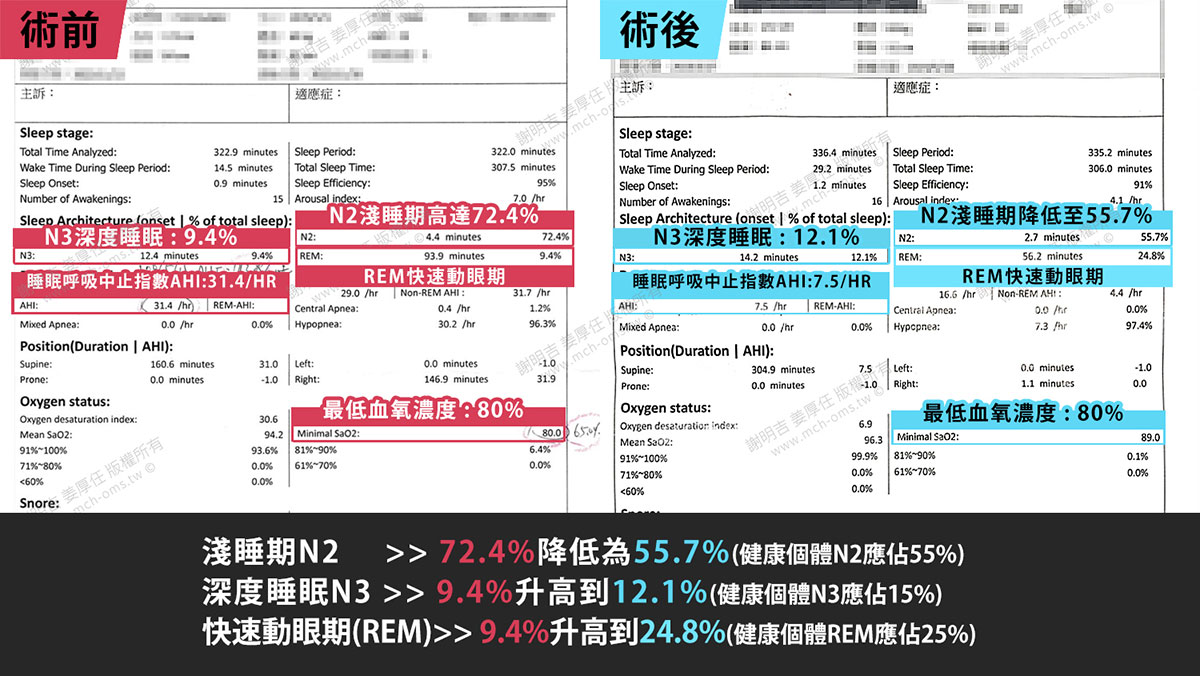| 术前症状 | 手术计画 |
| 重度睡眠呼吸中止症、情绪不佳、记忆退化以及认知功能障碍等临床症状。 | 拓宽呼吸道的正颚手术 |
一位很嗜睡的患者,带着睡眠报告前来求诊,报告显示他是重度睡眠呼吸中止(AHI = 31.4 /hr),因为长期缺乏快速动眼期睡眠(REM sleep),他也出现了情绪不佳、记忆退化以及认知功能障碍等临床症状。
多年来,他先后尝试了阳压呼吸器及止鼾牙套,但这几年有越来越无法适应的情况,会在睡眠中把这些帮助呼吸的辅助装置自己移除,自然就没有治疗效果,
所以他希望能寻求较根除性的手术治疗。我们为他执行了拓宽呼吸道的正颚手术(Maxillo-Mandibular Advancement)(MMA), 从电脑断层上可以看到阻塞的位置(悬壅垂以及舌根),得到很好的打通及拓宽,舌骨的位置有很明显向上以及向前的拉提。
术后的睡眠报告显示,睡眠呼吸中止指数(AHI)由31.4/hr降为7.5/hr,最低血氧浓度由80%升高到89%,睡眠结构也更接近健康的个体,原则上,治疗目标应该要减少浅睡期N2并且增加深度睡眠N3以快速动眼期(REM)的占比,浅睡期N2由72.4%降低为55.7%(健康个体N2应占55%),深度睡眠N3由9.4%升高到12.1%(健康个体N3应占15%),最重要的,快速动眼期(REM)由9.4%升高到24.8%(健康个体REM应占25%)。
因为深度睡眠的增加,这位患者手术后有比较睡饱充满电的感觉,心情也比较阳光正面,生活及工作都更有活力。
A very drowsy patient came to us with his sleep report, which showed that he had severe obstructive sleep apnea (AHI = 31.4/hr). Due to prolonged lack of rapid eye movement (REM) sleep, he also exhibited clinical symptoms such as poor mood, memory decline, and cognitive dysfunction.
Over the years, he had tried using positive airway pressure device (CPAP) and oral appliance. In recent years,however, he has found it increasingly difficult to adapt to these devices, often removing them during sleep, resulting in ineffective treatment.
He decided to seek a more radical surgical treatment.We performed a Maxillo-Mandibular Advancement (MMA) surgery designed to enlarge and stabilize his airway from collapsing during sleep. The CT scan showed the sites of the obstruction (uvula and tongue base), and we achieved a good opening and widening of the airway. The hyoid bone was significantly lifted upward and pulled forward from the advanced lower jaw.
Post-operative sleep reports showed that the apnea-hypopnea index (AHI) decreased from 31.4/hr to 7.5/hr, the minimum blood oxygen saturation increased from 80% to 89%, and the sleep structure became much closer to that of healthy individuals. Our aim was to decrease the proportion of light sleep (N2) while to increase the amount of deep sleep (N3) and REM sleep. According to the post-op sleep report, the light sleep N2 decreased from 72.4% to 55.7% (N2 should account for only 55% in healthy individuals), deep sleep N3 increased from 9.4% to 12.1% (N3 should account for 15% in healthy individuals), and most importantly, the REM sleep stage increased from 9.4% to 24.8% (REM should account for 25% in healthy individuals).
Due to the increase in deep sleep, the patient felt more refreshed and energized after the surgery, with a more positive mood and more vitality in life and work.
手术前后对比照


手术前后指数变化






